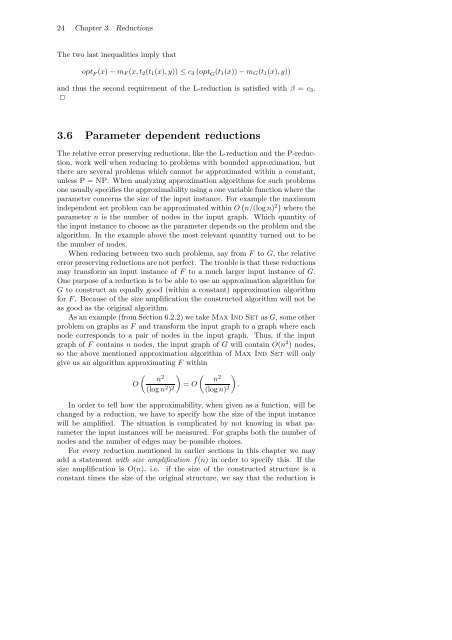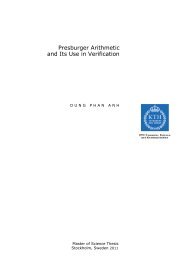On the Approximability of NP-complete Optimization Problems
On the Approximability of NP-complete Optimization Problems
On the Approximability of NP-complete Optimization Problems
You also want an ePaper? Increase the reach of your titles
YUMPU automatically turns print PDFs into web optimized ePapers that Google loves.
24 Chapter 3. Reductions<br />
The two last inequalities imply that<br />
opt F (x) − mF (x, t2(t1(x),y)) ≤ c3 (opt G(t1(x)) − mG(t1(x),y))<br />
and thus <strong>the</strong> second requirement <strong>of</strong> <strong>the</strong> L-reduction is satisfied with β = c3.<br />
✷<br />
3.6 Parameter dependent reductions<br />
The relative error preserving reductions, like <strong>the</strong> L-reduction and <strong>the</strong> P-reduction,<br />
work well when reducing to problems with bounded approximation, but<br />
<strong>the</strong>re are several problems which cannot be approximated within a constant,<br />
unless P = <strong>NP</strong>. When analyzing approximation algorithms for such problems<br />
one usually specifies <strong>the</strong> approximability using a one variable function where <strong>the</strong><br />
parameter concerns <strong>the</strong> size <strong>of</strong> <strong>the</strong> input instance. For example <strong>the</strong> maximum<br />
independent set problem can be approximated within O n/(log n) 2 where <strong>the</strong><br />
parameter n is <strong>the</strong> number <strong>of</strong> nodes in <strong>the</strong> input graph. Which quantity <strong>of</strong><br />
<strong>the</strong> input instance to choose as <strong>the</strong> parameter depends on <strong>the</strong> problem and <strong>the</strong><br />
algorithm. In <strong>the</strong> example above <strong>the</strong> most relevant quantity turned out to be<br />
<strong>the</strong> number <strong>of</strong> nodes.<br />
When reducing between two such problems, say from F to G, <strong>the</strong>relative<br />
error preserving reductions are not perfect. The trouble is that <strong>the</strong>se reductions<br />
may transform an input instance <strong>of</strong> F to a much larger input instance <strong>of</strong> G.<br />
<strong>On</strong>e purpose <strong>of</strong> a reduction is to be able to use an approximation algorithm for<br />
G to construct an equally good (within a constant) approximation algorithm<br />
for F . Because <strong>of</strong> <strong>the</strong> size amplification <strong>the</strong> constructed algorithm will not be<br />
as good as <strong>the</strong> original algorithm.<br />
As an example (from Section 6.2.2) we take Max Ind Set as G, someo<strong>the</strong>r<br />
problem on graphs as F and transform <strong>the</strong> input graph to a graph where each<br />
node corresponds to a pair <strong>of</strong> nodes in <strong>the</strong> input graph. Thus, if <strong>the</strong> input<br />
graph <strong>of</strong> F contains n nodes, <strong>the</strong> input graph <strong>of</strong> G will contain O(n2 )nodes,<br />
so <strong>the</strong> above mentioned approximation algorithm <strong>of</strong> Max Ind Set will only<br />
give us an algorithm approximating F within<br />
2 n<br />
O<br />
(log n2 ) 2<br />
2 n<br />
= O<br />
(log n) 2<br />
<br />
.<br />
In order to tell how <strong>the</strong> approximability, when given as a function, will be<br />
changed by a reduction, we have to specify how <strong>the</strong> size <strong>of</strong> <strong>the</strong> input instance<br />
will be amplified. The situation is complicated by not knowing in what parameter<br />
<strong>the</strong> input instances will be measured. For graphs both <strong>the</strong> number <strong>of</strong><br />
nodes and <strong>the</strong> number <strong>of</strong> edges may be possible choices.<br />
For every reduction mentioned in earlier sections in this chapter we may<br />
add a statement with size amplification f(n) in order to specify this. If <strong>the</strong><br />
size amplification is O(n), i.e. if <strong>the</strong> size <strong>of</strong> <strong>the</strong> constructed structure is a<br />
constant times <strong>the</strong> size <strong>of</strong> <strong>the</strong> original structure, we say that <strong>the</strong> reduction is

















